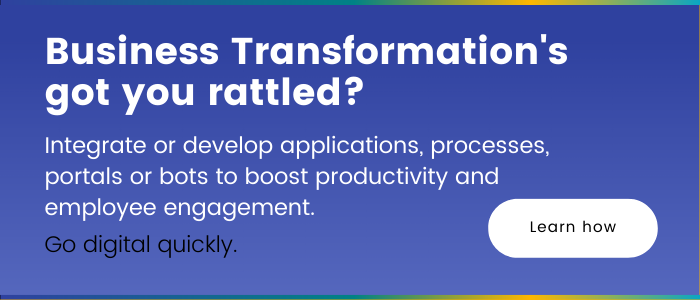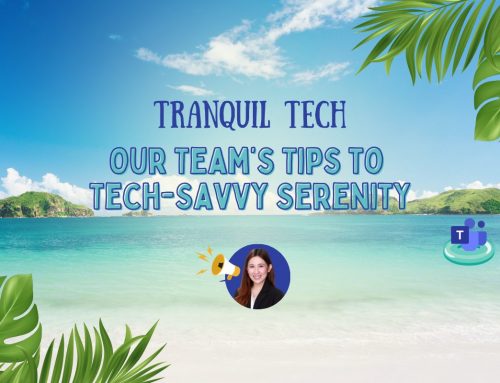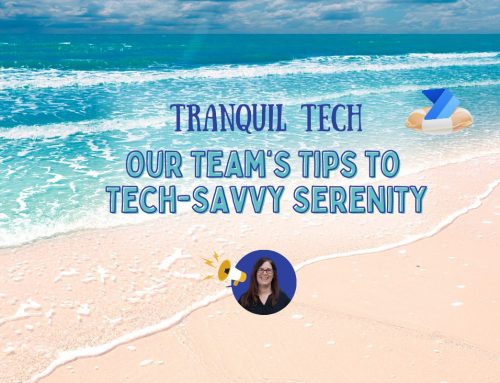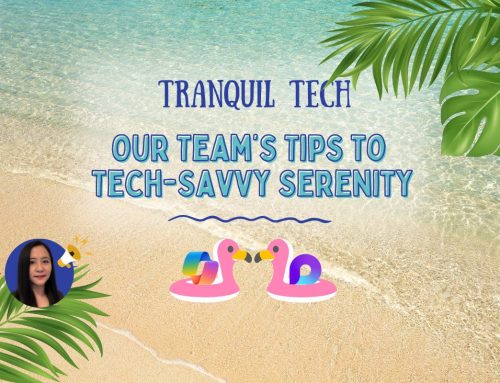An Introduction to Power Platform Centre of Excellence (CoE)
If you’ve hung around the IT world over the past few years, you’ve probably heard the term ‘digital transformation.’ It seems like everyone’s talking about it. But that’s about where it ends, talking about it. Not many companies are actually doing it, and if they are, there’s a good chance they’re struggling with it. Out of the millions of companies in the world, only a handful have not only done it but done it right.
So why are companies struggling to digitally transform? It comes down to people. You’d think technology is the answer, but it’s people. Most change initiatives fail due to cultural inertia, with 46% of CIOs reporting culture as the biggest barrier to success. One of the biggest puzzle pieces required to successfully embark on the digital transformation journey is a function of people with a plan. Establish this, and you’re miles ahead of most. That’s where the Centre of Excellence (CoE) comes in—it’s the puzzle piece most companies are missing. But before we dive into the Centre of Excellence, it’s important to understand the motivation behind a digital transformation.
Why digital transformations?
Many organizations have manual, repetitive, time-consuming processes. Think expense reporting, approvals, or invoice inputs. These tasks eat into your workday, reducing the time you have for other meaningful tasks. Digital transformations bring the ability to streamline these manual processes by digitizing and automating them. They accelerate requests and approvals, enable employees to innovate, and increase productivity, all while reducing costs and improving the ROI.
This sounds great and all, but why does this actually work? Well, people on the ‘front line’ who face these approvals, invoice inputs, and other poor workflows can create custom solutions. These involve building automated workflows, streamlined apps, and virtual bots. They have tools like AI, connectors and component libraries at their disposal without having to code. Overcoming the everyday challenges they face has never been easier. And then, when their solutions are up and running, the rest of the organization can adopt them, too, thanks to their simple interfaces. This reusability across the organization is what inspires innovation and drives down cost. Seems too good to be true, right? You’re probably wondering what the catch is. As I mentioned before, the catch is people. Starting a digital transformation is difficult when you don’t have a function of people with a plan. That’s why it’s so important to implement a Centre of Excellence
What is a Centre of Excellence?
The name may be misleading, but it isn’t a physical or virtual centre you use. Rather, it’s a coordinating function of people within your organization. It serves as a focal point to bring people together under a common business goal. In our scenario, they help align your digital transformation with your Power Platform strategy. This may sound intimidating, but establishing one doesn’t necessarily mean setting up a whole new team. In fact, they normally start small and include people with special knowledge from around your organization. Then, as your adoption expands, so will your CoE. They’re great for:
- Breaking down siloes, which helps people share knowledge throughout the entire organization, from best practices to research, to support
- Nurturing organic growth with governance and control at the core
They’ve become popular as digital transformations continue to sprout because they’re the most effective way to centre your organization around the transformation while keeping it ‘on the rails.’ It’s easy for things to get messy when an organization get’s a game-changing toolkit at its disposal. Employees build all kinds of solutions, so naturally, apps and flows become disorganized, or they run into compliance issues while building. CoEs help master engagement and alignment, which are the keys to a successful digital transformation.
CoE starter kit to the rescue
Just because getting started requires change doesn’t mean it isn’t doable. Even better, Microsoft put together a package to help anyone interested in beginning their digital transformation. CoE Power Platform Starter Kit is a collection of tools that’ll help you adopt and support the Power Platform. It’s the perfect gift for your organization’s CoE. Keep in mind that it simply helps you develop an adoption and support strategy; it doesn’t do everything for you. So how does a CoE help?
Imagine you work in IT and are tasked with setting up a system to answer all the questions below:
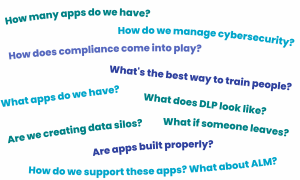
A list like this can feel daunting, and many don’t even know where to begin. Well, this is exactly what the Starter Kit helps with, and you don’t have to start from scratch. It’s basically IT’s secret weapon. But it isn’t just for IT. DevOps, Architects, Security, Tech Support, and your Citizen Developers can all use the CoE Starter Kit to make their lives easier. Like any new technology, as you adopt the Power Platform, things can get messy. Starting with an overview of how your organization uses it can help keep things clean while also giving insight.
Using the CoE in your organization
Some of you may be wondering how this kit could help within an organization, so here are two ways you can use the CoE Starter Kit to drive results:
Security:
Aid your cybersecurity team in finding security gaps. The Power Platform uses connectors to ‘communicate’ with other applications. Naturally, these connectors could pose potential security risks when transferring sensitive data from one piece of software to another. With the CoE Starter Kit, you can see what flow connectors are used, who’s using them, what sub-actions are used, etc.—making it easy to pinpoint risks and solve issues rapidly.
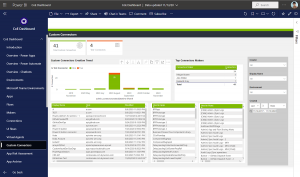
Innovation:
See who’s creating solutions, solution types, and their popularity. Easily piece together how your organization is innovating and discover the creative superheroes. These people are important to the evolution of your business, and using the Starter Kit is a steadfast way to unlock technological innovation opportunities like never before.
CoE starter kit: popping the hood
All of this sounds pretty cool, but how does it actually work? What’s inside? The kit is essentially a template for implementing best practices. Microsoft owns and updates it regularly, but it’s influenced by what they’ve seen companies implement on their own Power Platform journeys.
The kit comes with components containing a few main tools; a Dataverse data model, multiple apps, and Power BI analytics, which you can interact with to begin answering important questions like the ones above. Even better, the kit comes with automated workflows that collect resource information across your tenants’ environments. These flows automatically populate the tools with data from your organization. It’s a great way to gain end-to-end visibility of the platform and ultimately lay a foundation for you to build your own structure upon. If you’re interested in learning more about the tools, check out the CoE Starter Kit modules.
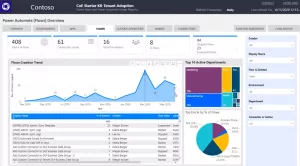
Centre of Excellence best practices
As they say, proper planning prevents poor performance— that’s no different here. Setting up a few key roles and responsibilities will take you a long way in your digital journey. We recommend implementing these five but feel free to choose the ones most relevant to your business. Remember, starting small is okay. As you adopt the Power Platform, innovation will grow, and so will your plan:
- Power Platform Admin team: they establish an environment strategy, set up DLP policies, and manage users, capacity, and licensing. They also help make data available to the people building solutions in your organization by utilizing connectors.
- Low Code Strategy team: they ensure the Power Platform Strategy is aligned with organizational goals. They’re also responsible for adoption, change management, and finding new ways of working across the organization.
- Power Platform Nurture team: helps organization members adopt and use the Power Platform to build solutions. The goal here is to get your organization members off to a great start. This can be done through creating Yammer communities (rebranding to Viva Engage), providing mentorship to solution builders, and hosting app-in-a-day events. If you’re looking for inspiration, we host XIAD events regularly. Sign up today to get in on the action.
- Re-usable Assets & Automation team: This team is important for efficiency. They’re concerned with setting up automation through Azure DevOps, holding architecture reviews with solution builders, and most importantly, creating a library of common templates and components.
- User Support team: If you’ve already got an IT team with a ticket support process and help desk guidance, then you can check this off the list.
We’re in this together
If you ever run into an issue, there’s an entire community dedicated to the Starter Kit, giving awesome options for support. If you have questions or want to check for answers on specific topics, you can check out the discussions forum to find your answer. Or let’s say you’re experiencing a bug. You can go to the issues tab to let Microsoft know. The team is quite fast with resolving issues. And to those of you with great ideas for features, you can even submit feature requests.
Next steps:
With the basics of a CoE, you’re ready to begin or rethink your digital transformation strategy with your team. With a fresh view at digital transformation you’re ready to move onto Microsoft’s page to begin setting up the kit. Unless you’d like us to help…
Remember, every organization is unique and will use this toolkit differently for its transformations. It gives you a base but leaves you the freedom to mold your CoE to meet goals unique to your organization.
Related Posts
Subscribe our newsletter
Enter your email to get latest updates.

